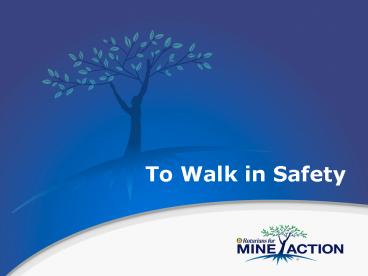To Walk in Safety PowerPoint PPT Presentation
1 / 22
Title: To Walk in Safety
1
To Walk in Safety
2
The Landmine Problem
- 45-50 million landmines in the ground in at least
70 countries. - Up to 20,000 people die or are maimed each year.
- More than 300,000 maimed landmine survivors
worldwide.
3
Why demining is so important
- Saves Lives
- Provides safe access to food and water
- Promotes peace and economic development
- Reduces poverty
4
Why demining is so important
- Helps ensure people have enough to eat
- Promotes self-sufficiency for individuals and
countries - Keeps families intact and healthy
- Protects at-risk refugee and displaced person
populations
5
What is a landmine?
6
A landmine is
- An explosive device set in place near or below
the surface of the ground (or water) designed to
explode on contact. - Tripwire activated
- Pressure activated
- The two main types are
- Anti-personnel landmines (APLs)
- Anti-vehicle landmines (AVLs)
7
Types of Landmines
- APL
- Blast APL
- Fragmentation APL
- AVL
- Blast AVL
- Penetration AVL
8
Unexploded Ordnance (UXO)
- Includes grenades, artillery shells, rockets and
aircraft bombs. These can be active for decades
after conflict. - Landmines and UXO can be rigged to create booby
traps and improvised explosive devises (IEDs),
which are a growing threat.
9
History of Landmines
- First used on a large scale in WWI, landmines
were planted throughout the 20th century as a
physical and psychological deterrent. - Despite treaties to mark location and perimeter
of mine fields, enforcement is difficult to
nonexistent.
10
Difficulties of Mine Clearance
- Detection and clearance are time-consuming,
expensive, and often occur in countries with poor
infrastructure. - Minefields are not always mapped or mapped
accurately.
- Mines are often placed around homes, schools,
roads and farm lands.
11
Consequences of landmines
- Blocked access to water sources
- Psychological trauma and financial ruin for
survivors. - Economic stagnation and dependence
- Human suffering and poverty
- Unusable farm land and food shortages
12
- A Fellowship committed to ridding the world of
mines and UXO and working to improve the lives of
people affected by mines. - Mine action projects fit within the World Service
component of Rotary. - Rotarians for Mine Action promotes
13
Mine Risk EducationTeaching safe behavior to
civilians in mine-affected areas.
14
Humanitarian DeminingDetecting and clearing
landmines and UXO.
15
Survivor AssistanceProviding medical,
psychological, and rehabilitation services
to landmine survivors and their families.
- Prosthetics
- Therapy
- Counseling
- Vocational training
16
Economic Development
- Building wells and water systems
- Building schools
- Providing micro credit
- Providing farm animals and tools
17
Getting Started with a Mine Action Project
18
Getting Started
- Using the Rotarians for Mine Action
(www.rfma.org) website - Choose the type of project you want (mine
removal, survivor assistance, etc.). - Find a partner NGO in the Rotary resource
directory on the website. - Email the partner listed in the database to
discuss a joint project.
19
Explore a District-Wide Initiative
- More clubs and increased resources allow
larger-scale projects, i.e. demining an entire
village. - Coordinating with other clubs expands your Rotary
fellowship and friendships.
20
Multi-district Projects
- Ask your World Community Services chair for
contacts in other districts. - Decide on a project and a lead person.
- Register your project on the www.rfma.org web
site.
21
Checking on your project
- Ask your partner NGO about visiting your project.
- Update the RFMA.org project website during and
after project completion.
22
Sources of Information
- Source material for this presentation came from
the Landmine Action Smart Book, first and second
editions, edited by the Mine Action Information
Center, James Madison University, Harrisonburg,
VA, USA - Produced by Sally Bader Mackle, Rotary Club of
Seattle, 2005 - Thank you to the following for the use of their
photos, assistance and information - HALO Trust, Edward Jellen, Sally Bader Mackle,
Mines Advisory Group (MAG), One Sir Lanka
Foundation, Rotarians for Mine Action, US
Department of State, Office of Weapons Removal
and Abatement

